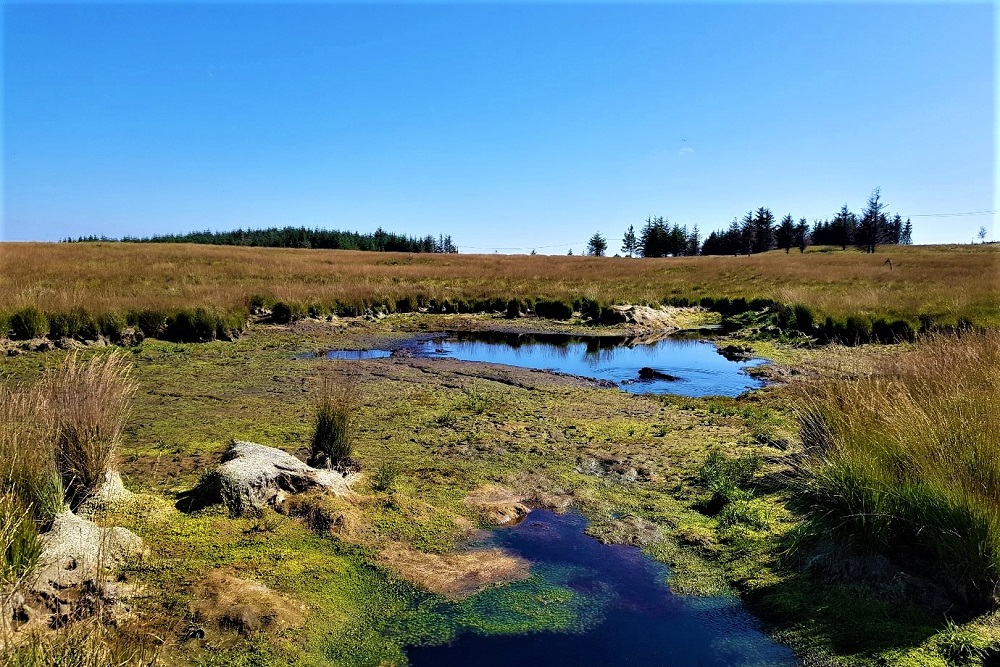Lost peatlands project restores large area of rare bog habitat

A large area of area of bog habitat has been successfully restored as part of an ongoing project to protect peatland in south Wales.
The Lost Peatlands of South Wales Project which is funded by the National Lottery has been working through the winter months to restore the 23 hectare site which forms part of the upland landscape between Neath Port Talbot and Rhondda Cynon Taf.
The globally rare habitat has a wealth of natural assets which, if managed carefully, can have a big impact on human-induced climate change while also reversing biodiversity decline.
Project organisers say that peatland management is one of the crucial tools in the world’s approach to achieving its carbon goals as they are among the most carbon-rich ecosystems on Earth, storing around 25% of total soil carbon while only occupying 3% of the global land area.
Peatlands in good condition act as a carbon sink – locking in vast amounts of carbon formed over millennia – and they can also reduce flood risk, improve water quality, support biodiversity and have a net cooling effect on climate.
When peatlands are damaged, however, they become a significant carbon emitter, so the project aims to assess the peatlands in the area and determine how best to restore them.
This is typically done by focusing on the hydrology of an area, and through restoration works the ‘re-wetting’ of peatlands will allow their return to a near natural state.
Following extensive surveys of previously afforested areas in the Welsh Government Woodland Estate, three sites were identified and brought forward by Natural Resources Wales for restoration.
Exposed and degraded
Following the Second World War, commercial forestry dominated this landscape responding to a demand for UK frown timber in the 1950s.
To achieve this, areas of peatland were drained through channels ploughed into the landscape, and as a result the water level has since dropped, leaving these habitats exposed and degraded.
This dried peat is either lost to the atmosphere or washed downstream, and along with it goes vast amounts of organic carbon formed over millennia.
These bog systems can be restored by ‘re-wetting’ them, bringing the water level back to the surface and once back to a near natural state, carbon will be locked in so that Sphagnum moss can once again spread and continue to create these unique wetlands.
There are many ways to re-wet and restore bog systems or ‘mires’, with most techniques simply blocking drainage channels or areas of surface run-off.
This is done by physically putting in dams made of wood or metal/plastic piling, or by re-working the land to form dams or bunds made of peat itself.
For the first project site up for restoration – Castell Nos Habitat Restoration Area – a series of small peat dams have been ‘keyed’ into the existing drainage channels.
This is already holding back water thus raising the water table. Cross tracking – where an excavator drives over the peatland – is also a technique used here to generally flatten the landscape, reducing drainage and creating good conditions for Sphagnum moss.
This site is classed as a trial example for restoring previously afforested peatlands.
To analyse the work, project ecologists, Swansea University and volunteers will be monitoring the site for aspects such as ground water levels, water quality and vegetation composition.
Key project
Cllr Jeremy Hurley, Neath Port Talbot Council’s Cabinet Member for Climate Change and Wellbeing, said: “Once data is collected on this project it will help fill in the evidence gaps in scientific literature regarding restoration in this scenario and that will be a key project outcome – informing best practise for future peatland work – both in Wales and beyond.”
Rhys Jones, Conservation Land Management Team Leader from Natural Resources Wales said: “We’re proud to deliver restoration on Castell Nos this year as part of the Lost Peatlands Project.
“The previously afforested land has served us well in its purpose as a managed forest which also provided a service to carbon sequestration, water management, cooling, and as habitat for local biodiversity.”
This work is funded through the National Lottery Heritage Fund and delivered in partnership between Neath Port Talbot and Rhondda Cynon Taf Councils, Natural Resources Wales, Swansea University and Coed Lleol.
More information on the project can be found on the project website on social media @LostPeatlands, or for anything specific you can get in touch by email
Support our Nation today
For the price of a cup of coffee a month you can help us create an independent, not-for-profit, national news service for the people of Wales, by the people of Wales.





What a joke! The Welsh government has permitted the destruction of peatland all over Wales to erect wind turbines which require the gouging out of masses of peat to make holes into which thousands of tons of concrete are poured to make the base. Then there are all the access roads carved out of hillsides, etc.